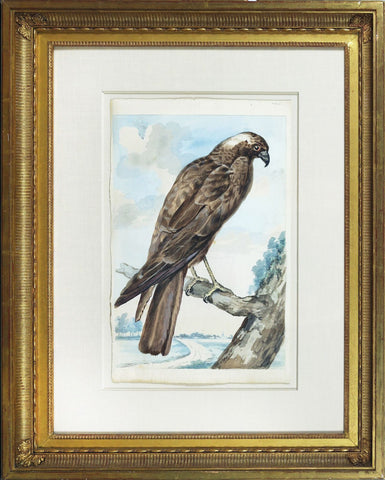
George Edwards (British, 1694-1773), A Bird of the East Indies
George Edwards (British, 1694-1773)
A Bird of the East Indies
Watercolor on paper
Inscribed lower left: 24
Paper size: 9 1/2 x 12 in
Frame size: 19 x 21 in
References: Nissen IVB 286, 288; Fine Bird Books, p.73; Anker 124, 126; Lisney, p.128 seq.
Inscribed above in manuscript: ‘This bird is in the collection of Alexander Russell M.D. it was brought from the East Indies, it is drawn of its natural size from the bird preserved dry. The insides of the wings are of a dark ash colour the edges of the feathers lighter colourd, the tail dark ash colourd beneath all that part colourd green is glossey like polished mettle and changable like the colours in humingbirds. I take it to be a bird hitherto undescribed. Geo Edwards March 1768’
George Edwards (British, 1694-1773)
As a young man, George Edwards found himself among the most influential natural historians, collectors, and artists of the 18th-century. Among Edwards’ first patrons was Sir Hans Sloane. He was taught to etch by the celebrated Mark Catesby (in 1754 he would publish the second edition of Catesby’s “Natural History...”); he worked with the Bartrams of Philadelphia and Linnaeus in Sweden.
He is most famous for his book titled: A Natural History of Uncommon Birds - Gleanings of Natural History, which has been deemed the most important of all bird books (Fine Bird Books). One of the most important of all eighteenth-century natural history works, “at its date of issue, the “Natural History” and “Gleanings” was one of the most important of all bird books, both as a fine bird book and as a work of ornithology. It is still high on each list” (Fine Bird Books). The first volume of “A Natural History of Uncommon Birds” was published to great acclaim in 1743, and gained him a nomination for a Royal Society fellowship, although he withdrew his candidacy.
The second and third volumes followed in 1747 and 1750, which won him the coveted Copley medal of the Royal Society. The last volume appeared in 1751, at which time he stated that age and infirmity precluded further work. In 1758, he published the first volume of his “Gleanings of Natural History,” the second in 1760, after which he sold his entire portfolio to the Marquess of Bute, “...resigned as Bedell to the College of Physicians, and retired to a house in Plaistow. He still visited the college and the Royal Society and, stimulated by his drawings of South American birds captured from the French by Earl Ferrers, published the last volume of “Gleanings...” in 1764. Bibliographically, Edwards’ “a Natural History...” is complicated. A large number of possible variants exist, but what is certain is that it was hugely successful and went through several transformations while under Edwards’ control, including the issuing of a French edition of the text.
Please feel free to contact us with questions by phone at 215.735.8811,or by email at loricohen@aradergalleries.
We Also Recommend





